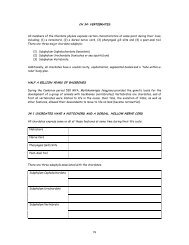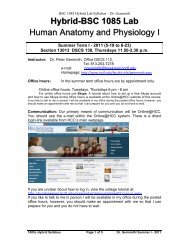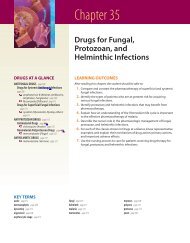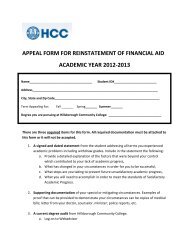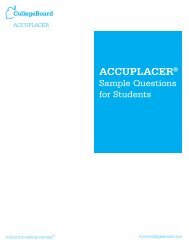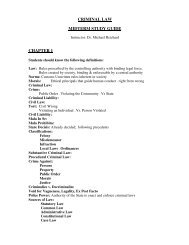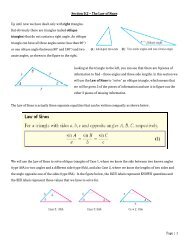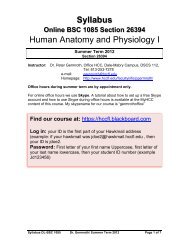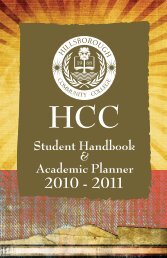Antimicrobial Drugs
Antimicrobial Drugs
Antimicrobial Drugs
Create successful ePaper yourself
Turn your PDF publications into a flip-book with our unique Google optimized e-Paper software.
M34_ADAM9811_03_SE_CH34.QXD 12/30/09 1:16 PM Page 502<br />
502 Unit 5 The Immune System<br />
NURSING PROCESS FOCUS<br />
PATIENTS RECEIVING ANTITUBERCULOSIS DRUGS<br />
Assessment<br />
Potential Nursing Diagnoses<br />
Baseline assessment prior to administration:<br />
■ Understand the reason the drug has been prescribed in order to assess for<br />
therapeutic effects.<br />
■ Obtain a complete health history including neurologic, cardiovascular,<br />
respiratory, gastrointestinal hepatic or renal disease, and the possibility of<br />
pregnancy. Obtain a drug history including allergies, including specific reactions<br />
to drugs, current prescription and OTC drugs, herbal preparations, and alcohol<br />
use. Be alert to possible drug interactions.<br />
■ Assess signs and symptoms of current infection noting symptoms, duration, or<br />
any recent changes. Assess for concurrent infections, particularly HIV.<br />
■ Evaluate appropriate laboratory findings (e.g., CBC, AFB C&S, hepatic and renal<br />
function studies).<br />
Assessment throughout administration:<br />
■ Assess for desired therapeutic effects (e.g., diminished signs and symptoms of<br />
infection, fever, night-sweating, increasing ease of breathing, decreased sputum<br />
production, improved radiographic evidence of improving infection).<br />
■ Continue periodic monitoring of CBC, and hepatic and renal function.<br />
■ Assess for adverse effects: nausea, vomiting, abdominal cramping, diarrhea,<br />
drowsiness, dizziness, paresthesias, tinnitus, vertigo, blurred vision, changes in<br />
visual color sense, and increasing fatigue. Eye pain, acute vision change, sudden<br />
or increasing numbness or tingling in extremities, decreased hearing or<br />
significant tinnitus, and increase in bruising or bleeding should be immediately<br />
reported.<br />
Planning: Patient Goals and Expected Outcomes<br />
■<br />
■<br />
■<br />
■<br />
■<br />
■<br />
Infection<br />
Fatigue<br />
Imbalanced Nutrition, Less than Body Requirements (related to<br />
fatigue, adverse drug effects)<br />
Deficient Knowledge (drug therapy, infection control measures)<br />
Risk for Noncompliance (related to adverse drug effects, deficient<br />
knowledge, length of treatment required, or cost of medication)<br />
Risk for Social Isolation (related to disease, length of treatment)<br />
The patient will:<br />
■ Experience therapeutic effects (e.g., diminished signs and symptoms of infection, decreased fever and fatigue, increased appetite).<br />
■ Be free from, or experience minimal, adverse effects.<br />
■ Verbalize an understanding of the drug’s use, adverse effects, and required precautions.<br />
■ Demonstrate proper self-administration of the medication (e.g., dose, timing, when to notify provider).<br />
Interventions and (Rationales)<br />
Ensuring therapeutic effects:<br />
■ Continue assessments as described earlier for therapeutic effects. (Diminished<br />
fever, cough, sputum, and other signs and symptoms of infection should be<br />
noted.)<br />
■ Recognize that tuberculosis treatment requires long-term compliance and many<br />
reasons exist for noncompliance. (Noncompliance may increase the risk to the<br />
patient’s health, family and community health, and promotes the development<br />
of resistant organisms. Monitoring of drug administration may be required to<br />
ensure therapy is continued.)<br />
Minimizing adverse effects:<br />
■ Continue to monitor vital signs, breath sounds, and sputum production and<br />
quality. Immediately report undiminished fever, increases in sputum production,<br />
hemoptysis, or increase in adventitious breath sounds to the health care<br />
provider. (Increasing signs of infection may signify drug resistance or significant<br />
noncompliance with drug regimen.)<br />
■<br />
Continue to monitor periodic lab work: hepatic and renal function tests, CBC, and<br />
sputum culture for AFB. (Antituberculosis drugs are hepatic and/or renal toxic.<br />
Periodic C&S tests may be ordered if infections are severe or are slow to resolve<br />
to confirm appropriate therapy. Drug levels will be monitored on drugs with<br />
known severe adverse effects.)<br />
Implementation<br />
Patient Education/Discharge Planning<br />
■<br />
■<br />
■<br />
■<br />
Teach the patient to not stop drugs when “feeling better” but to<br />
continue prescribed course of therapy; do not share doses with other<br />
family members with similar symptoms; and return to provider if<br />
adverse effects develop to ensure drug therapy is maintained.<br />
Discuss with the patient concerns about cost, family members who<br />
have similar symptoms or may need prophylactic treatment, and how<br />
to manage adverse effects to help encourage compliance.<br />
Teach the patient to promptly report a fever that does not diminish<br />
below 100°F; continued symptoms of disease (e.g., night sweating,<br />
fatigue); or increase in sputum production to the health care provider.<br />
Instruct the patient on the need for periodic lab work.<br />
# 102887 Cust: PE/NJ/CHET Au: ADAMS Pg. No. 502<br />
Title: Pharmacology for Nurses Server: Jobs2<br />
C/M/Y/K<br />
Short / Normal<br />
DESIGN SERVICES OF<br />
S4CARLISLE<br />
Publishing Services



